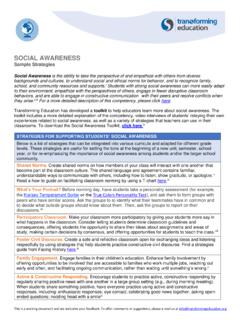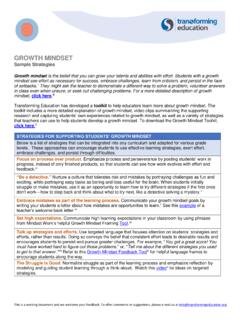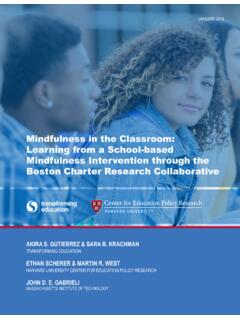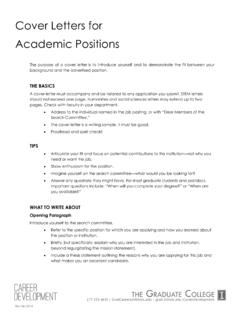Transcription of Resources and Sample Strategies for Social Emotional ...
1 1 Resources and Sample Strategies for Social Emotional Learning and School Culture & Climate Developed by & Last updated 7/14/15 Do you have suggestions for improving these Resources ? Email us at 2 TABLE OF CONTENTS Social Emotional LEARNING .. 3 GROWTH MINDSET .. 3 SELF-MANAGEMENT .. 4 SELF-EFFICACY .. 5 Social AWARENESS .. 6 GENERAL SEL Resources : .. 6 CULTURE & CLIMATE .. 7 CLIMATE OF SUPPORT FOR ACADEMIC LEARNING .. 7 KNOWLEDGE AND FAIRNESS OF DISCIPLINE, RULES AND NORMS .. 8 SAFETY .. 10 SENSE OF BELONGING (SCHOOL CONNECTEDNESS) .. 11 SOURCES .. 12 Do you have suggestions for improving these Resources ? Email us at 3 Social Emotional LEARNING GROWTH MINDSET The belief that you can grow your talents and abilities with effort. Students with a growth mindset see effort as necessary for success, embrace challenges, learn from criticism, and persist in the face of setbacks.
2 For a more detailed description of this competency, click here. Transforming Education has developed a toolkit to help educators learn more about growth mindset. The toolkit includes a more detailed explanation of growth mindset, video clips summarizing the supporting research and capturing students own experiences related to growth mindset, as well as a variety of Strategies that teachers can use to help students develop a growth mindset. To download the Growth Mindset Toolkit, click here. Sample Strategies (* excerpted directly from Carol Dweck interview) Praise Effort and Process Over Results Use targeted language that focuses attention on practice rather than results to convey the belief that consistent effort leads to desirable results: Wow, you did great on that. You must have worked really hard. Tell me about the different Strategies you used to get to that answer. Nurture a Culture That Tolerates Risk and Mistakes Portray challenges as fun and exciting, while portraying easy tasks as boring and less useful for the brain.
3 When students initially struggle or make mistakes, the teacher should view this as an opportunity to teach students how to try different Strategies if the first ones don't work how to step back and think about what to try next, like a detective solving a mystery.* Think of the Brain as Something That Grows Work with your students to create posters or other reminders that the brain, like a muscle, grows and gets stronger with effort. Encourage Students to Share Advice Have students write a letter to a struggling student explaining the growth mindset, telling the struggler not to label himself or herself, and giving the student advice on improvement Strategies to try.* Emphasize Process and Perseverance Instead of displaying only finished student work, post work in progress or drafts so students can see how work evolves with effort and feedback. Emphasize that fast learning is not always the deepest and best learning and that students who take longer sometimes understand things at a deeper level.
4 Students can learn about many historical figures who were not regarded as "fast" learners in childhood. Albert Einstein swore that he was slow to learn and that's why he pondered the same questions year after year with, as we know, excellent results.* Additional Readings & Resources : Interview with Carol Dweck on Growth Mindset A more detailed definition of Growth Mindset Even Geniuses Work Hard: Strategies for Developing a Growth Mindset The Power of Mistakes: Creating a Risk-Tolerant Culture at Home and School Students View of Intelligence Can Help Grades Growth Mindset Gaining Traction as School Improvement Strategy TED Talk on Mindsets and Success Do you have suggestions for improving these Resources ? Email us at 4 SELF-MANAGEMENT The ability to effectively manage your emotions, thoughts, and behaviors in different situations. This includes managing stress, delaying gratification, motivating yourself, and setting and working toward personal and academic goals.
5 For a more detailed description of this competency, click here. Transforming Education has developed a toolkit to help educators learn more about self-management. The toolkit includes a more detailed explanation of self-management, video clips summarizing the supporting research and capturing students own experiences related to self-management, as well as a variety of Strategies that teachers can use to help students develop self-management skills. To download the Self-Management Toolkit, click here. Sample Strategies (*adapted from Character Lab) The WOOP Method - The WOOP strategy, which is positive thinking plus a dose of reality, contains four steps: Wish: Students name an important but feasible wish or goal that they want to fulfill. Outcome: Students imagine, as vividly as possible, what the future will be like once they fulfill this wish or reach the goal. Obstacle: Students imagine the most critical personal obstacle that stands in the way of fulfilling that wish or reaching the goal.
6 plan : Students name an effective behavior to overcome the obstacle and create a specific plan using an if-then statement: If X happens, then I will Y. * Student Self-Monitoring Create clear self-management expectations and provide opportunities for students to track their own progress towards these goals over time. Consider adding a public reporting component. Readiness to learn: Create a checklist and set aside time at the beginning of class for students to assess their readiness to learn: Do I have all the tools to learn? Books, pen, notebook, Track the results so that students can see progress over time. Classroom behavior: Create a simple series of expectations for students that they can track. Am I listening to others? Am I waiting for people to finish before I talk? Am I using appropriate language to disagree? Am I using an appropriate tone and not raising my voice? At the end of each class, have students rate themselves and record their results.
7 Create Awareness of When Students Learn Best Help students understand when they learn best so that they can seek out and create situations to maximize their learning. Each student creates a list that completes the phrase I focus best or I learn best Ask each student to identify three things to seek related to when they learn best and three to avoid. Students record how often these situations occur and track their progress over time. Additional Readings & Resources : More on the WOOP Method Multimedia Resources for Self-Regulation Interview about the Marshmallow Experiment University of Michigan Emotion & Self-Control Lab Instructional Strategies for Self -Management and Classroom Management Book on the Marshmallow Test The Duckworth Lab Resources for Educators Don t!: The secret of self-control Do you have suggestions for improving these Resources ? Email us at 5 SELF-EFFICACY The belief that you can succeed in achieving an outcome or reaching a goal.
8 Self-efficacy reflects confidence in your own ability to control or manage your motivation , behavior, and environment. For a more detailed description of this competency, click here. Sample Strategies (adapted from materials developed by the motivation Research Institute and from the article entitled Golden Rules for Engaging Students in Learning Activities ) Define Success in Clear and Relevant Ways: Focus on learning activities that are relevant and engaging so that students see inherent value in succeeding Set clear, developmentally-appropriate expectations about what success looks like in a particular context Model (or have other students model) what success looks like, Prior to starting a new task, mentally walk students through the task to visualize what it will take to reach the goal Display pictures or videos of students at work on projects with comments about the skills being demonstrated Build A Sense of Momentum and Progress.
9 Teach students about growth mindset and help them understand that they can build their skills with practice and effort Break big goals into smaller pieces to create opportunities for small wins along the way Focus on what s already been achieved by showing students that they re already X% of the way to meeting their goal (even if X is a low number) Celebrate each incremental step towards the goal to give students the experience of being successful in small ways Create opportunities for students to regularly demonstrate their growing understanding throughout the activity Provide task-specific (rather than ability-focused) feedback to help students improve their performance Ask students to identify specific times that they feel confident in their ability to succeed and describe what they re thinking and feeling in those moments Address Potential Barriers to Success: Make sure that students have the time and Resources needed to reach their goals Acknowledge competing demands on students time and make a plan together about how to prioritize accordingly Ensure that students feel physically and psychologically safe when engaging classroom activities Additional Readings & Resources : motivation Research and Assessment Resources Golden Rules for Engaging Students in Learning Activities Video Lecture on Self Efficacy Do you have suggestions for improving these Resources ?
10 Email us at 6 Social AWARENESS The ability to take the perspective of and empathize with others from diverse backgrounds and cultures, to understand Social and ethical norms for behavior, and to recognize family, school, and community Resources and supports. For a more detailed description of this competency, click here. Sample Strategies (adapted from the article entitled 3 Strategies to Foster Sociability ) Create A Common Social Language & Shared Norms One of the most effective Strategies to teach Social skills in school is to create a common Social language that becomes part of the classroom culture. This language contains familiar, understandable ways to communicate with others, including how to listen, show gratitude, or apologize. When students are actively engaged in setting Social norms, research shows that cooperative behavior and learning increases. As a result of their involvement, students come to understand the benefits of collaboration.









